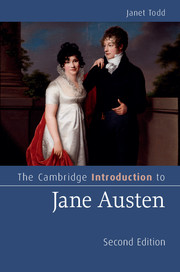Book contents
- Frontmatter
- Contents
- Preface to the second edition
- Preface to the first edition
- List of abbreviations
- 1 Life and times
- 2 The literary context
- 3 Northanger Abbey
- 4 Sense and Sensibility
- 5 Pride and Prejudice
- 6 Mansfield Park
- 7 Emma
- 8 Persuasion
- 9 Austenmania: Jane Austen's global life
- Afterword
- Notes
- Further reading
- Index
- Cambridge Introductions to …
Afterword
Published online by Cambridge University Press: 05 March 2015
- Frontmatter
- Contents
- Preface to the second edition
- Preface to the first edition
- List of abbreviations
- 1 Life and times
- 2 The literary context
- 3 Northanger Abbey
- 4 Sense and Sensibility
- 5 Pride and Prejudice
- 6 Mansfield Park
- 7 Emma
- 8 Persuasion
- 9 Austenmania: Jane Austen's global life
- Afterword
- Notes
- Further reading
- Index
- Cambridge Introductions to …
Summary
To return to the writing: there is no complete and easy answer as to why Jane Austen, a novelist who enjoyed a modicum of success during her lifetime, nowadays has such a wide appeal, while the most popular authors of her period – those whom she herself admired – Samuel Richardson, Frances Burney, Maria Edgeworth, and Walter Scott, are rarely read for pleasure. It seems that Austen's fiction – like Sir Walter Elliot's face – has aged well ‘amidst the wreck’ of her contemporaries. I have suggested that her success is due to her unrivalled creation of plausible characters and their idiolects, her melding of emotional analysis and psychological acuity with social satire and comedy. Also, size may matter: Austen's minimalist narrative style distinguishes her from both her contemporaries and the great writers who followed her in the nineteenth century, the Brontës, George Eliot, Charles Dickens, and Henry James. She ‘lop't & crop't so successfully’ (L, p. 202) throughout much of her creative process until only a fast-paced narrative remained – the ramblings of Scott's colourful peasant folk may safely be skipped, as can the satirical spates of Burney's whimsical oddballs, but readers who mistake Miss Bates's compulsive chatter as equally immaterial to the plot will find themselves lacking pieces in the puzzle that is Jane Fairfax's secret engagement. And Austen's novels do not contain any of the tedious excursions characterising the fiction of her period: to omit ‘long Chapter[s] – of sense’, ‘an Essay on Writing, a critique on Walter Scott, or the history of Buonaparte’ (L, p. 203) was her conscious aesthetic decision – one which may have lost her critical appreciation among reviewers at the time but one which has secured her popularity in a century when literary didacticism has fallen from fashion.
Austen's popularity may also be due to her ‘limitation’ – that recurring axiom in Austen criticism. Unlike the heroic tales of Scott, her fiction, while drawing on its social and historical moment, eschews explicit reference to the political revolutions of the eighteenth and early nineteenth centuries; for contemporary readers it is not anchored within a specifically defined period (it is films that create the fantastical Regency). Even exterior detail is scarce.
- Type
- Chapter
- Information
- The Cambridge Introduction to Jane Austen , pp. 152 - 153Publisher: Cambridge University PressPrint publication year: 2015

